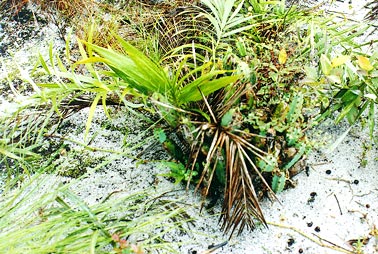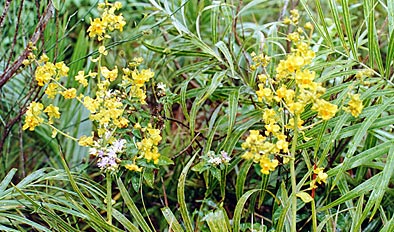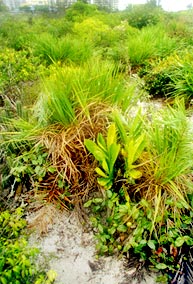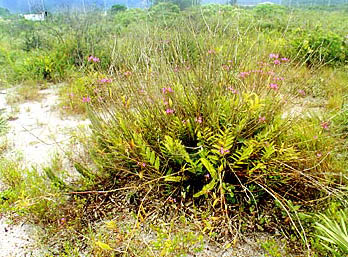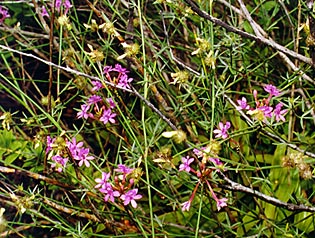 |
 |
The
occurrence of Cyrtopodium polyphyllum (Vell) F. Barros ex Pabst, Epidendrum
denticulatum Barb. Rodr. and Catasetum sp. in the sandbanks of Barra
da Tijuca. No matter if we know it by Cyrtopodium paranaense Schltr. or Cyrtopodium polyphyllum (Vell) F. Barros ex Pabst, or even "Sumaré" or "Cola de sapateiro" (cobbler glue), the fact is that species is present in almost coastal Brazilian states, namely, between others, Paraíba, Pernambuco, Alagoas, Sergipe, Bahia, Rio de Janeiro, São Paulo, Paraná, Santa Catarina, Rio Grande do Sul, as well as Brasília and Brazilian Amazon, in the state of Pará. |
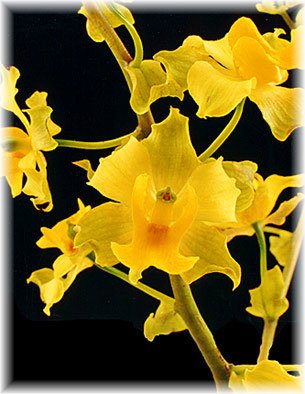 |
Cyrtopodium
polyphyllum (from
2,5cm but never reaches |
|
This
species grows in scalding sand receiving directly sun and wind all day round however, under the layer of sand there is black organic earth. |
|
In
despite of this vegetative habit, it also appears as rupicolous in hillsides at
low altitude and far from the coast (Lou Menezes, Cyrtopodium polyphyllym,
in Orquidário, Volume12, nº4, l998) and it is cultivated for many
growers as epiphyte (fibre fern). As stated by Pabst (Orquídea Set-Outubro l966), due to the winds of the sandbanks, the plants are buried with sand and tend to put roots in the inter-nodes and vegetative buds in the middle of the pseudobulbs. This species has been described by Vellozo in l827 as Epidendrum polyphyllum and published in Flora Fluminense in the same year . In l920, Schlechter described it as Cyrtopodium paranaense Schltr. In l994, Fabio Barros published it in "Acta Botânica Brasileira" as Cyrtopodium polyphyllum (Vell.) F. Barros ex Pabst because Pabst had already recognised that nomenclature as corrected. Everything suggests that the sandbank of Jacarepaguá and Barra da Tijuca were a privileged habitat of its species, unfortunately the expansion of the city in those directions provoked (and still provokes) a pitiless destruction of kilometres of those habitats. Nothing has been done. |
In
spite of this situation, this Cyrtopodium bravely withstands, the first
time we went to one of those remained habitats, we found nothing but a burned
pseudobulb in as place where the caterpillar tractor had passed recently followed
by a fire. |
|
How
surprise are we when returned to the same place a year later and we found a multitude
of them blooming among Epidendrum denticulatum Barb Rodr. It was the peak of the blooming season, just before Christmas even, and the spectacle provoked by the mix of the yellow flowers with the pinkish or darker flowers (when they got older) of this Epidendrum was very impressive. |
|
On another very close place, besides those two species, we also found just one, wonderful, exuberant specimen of Catasetum gardneri. Three years later, I always ask myself, if it is still there or if in that place there is a play-ground, a swimming pool or just nothing. |
|
Epidendrum
denticulatum Barb Rodr. also occurs in many Brazilian states, namely, Pernambuco,
Bahia, Minas Gerais, Rio de Janeiro, São Paulo, Paraná, Santa Catarina
and Rio Grande do Sul, among others. Its dispersion is quite generous in Rio de Janeiro city and we still see it blooming at Urca hill, Barra da Tijuca, Jacarepaguá sandbanks. The list of occurrence is quite big: Praia Vermelha, Avenida Niemeyer, Alto da Boa Vista, Corcovado, Av. Sernambetiba, Pedra de Itaúna, etc... It also occurs in Massambaba sandbanks in the state of Rio de Janeiro. |
|
|
Consulting
the famous Pabst's card file (see Orchid News # 12), we find notes about very
interesting variations: the plants that grow (or grown) in Praia Vermelha (Urca)
are different from those that grow (or grown) in Niemeyer avenue concerning the
number of callus in the lip, size of the floral spikes, consistency of the leaf
and blooming season although there are just few kilometres separating them. The flowers are light lilac, pinkish and 1,5cm across. The sepals are oblong-ovalate with 7mm x 4mm. The petals are narrower. The lip is trilobed and united with the column in the vertex. |
|
It can present 3 or 5 white round callus and can present small whiskers in the
extremity of the lobes. The anther is green and the stem is cylindrical an reaches from 50cm to 60cm. The leaves are sessile, opened, coriaceous, oblong-ovoid, a little sharp and have 5cm against 1,5cm across. It presents raceme of 20cm with a small apical bunch with from 5 to 8 flowers simultaneously opened. While the old flowers wilt, news buds open. |
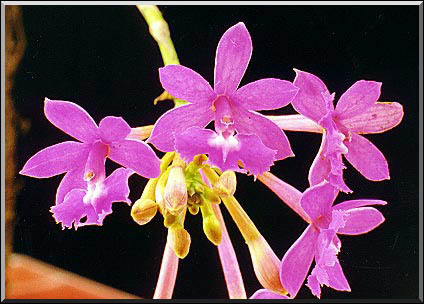 |
It
blooms during the summer and fall, depending on the place. This species is often confused with Epidendrum ellipticum Grah. the mainly difference is in the callus of the lip, in Epi. denticulatum, it is white and has 3 (or 5 as verified by Pabst) distinct and ovoid excrescence, in the other, the callosity is yellow and frilly. |
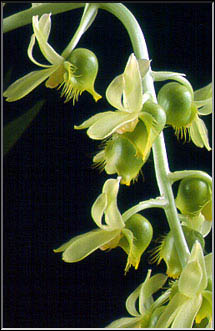 |
Concerning
the Catasetum, the doubt is raised, it would be Catasetum gardneri
Schltr. or Catasetum discolor Lindl.. According to Pabst, this a question of synonymies, to some researches, there two different species. Catasetum gardneri Schltr. would occurs from the state of do Rio de Janeiro until Pará and Catasetum discolor Schltr. just in the states of Amazonas and Pará (Marcos Antonio Campacci, in Flora Brasileira, Orquídesa (1), Cd rom). According to Kleber Lacerda (see in the interview in this issue), there is no way to confuse one with the other: Ctsm. gardneri (known as Ctsm. discolor var. fimbriatum) occurs with terrestrial habits in the coast of the Southeast and Northeast of Brazil, has smaller flowers and the female flowers are small and characteristically elongated; Ctsm. discolor is a species that occurs predominately in Amazon region although it also occurs in other kinds of vegetation in neighbour areas in Brazil and Venezuela. The female flowers are globular and bigger. |
Catasetum
discolor var. fimbriatum, has been found in l965, by Dressler, in Reserva
Biológica de Jacarepaguá, (Biological Reserve of Jacareaguá),
in Rio de Janeiro; in l974, by Ms.. R. Kautsky, at Praia do Sol, in the state of Espírito Santo; in l977, by Angelo Pires, in a beach in São Mateus, in the same state and in l972, at the Restinga (Sandbank) de Jacarepaguá, in the sand. Its occurrence could verified in Friburgo (State of Rio de Janeiro). Therefore far from the beach, according to the notes taken by Guido Pabst in his cards. This species has the lip extensively ahead projected, the apex is round with long fleshy eyelashes. The flowers are light yellow or greens and at about 3cm across. Maria da Penha Fagnani, in her work called "Orquídeas da Restinga de Massabamba, II" with Carlos Ivan da Silva Siqueira, published in Volume7, nº 2, Orquidário, besides informs us that this species owns to a group that is one the most primitive of the genera because it have just rudiments of the antennas, give a little profile of the habitat in this region: " ... we found a small terrestrial population growing in a depression next to the sand dunes which soils seems (after a superficial exam), a mix of clay and sand. The area is periodically flood..." |
|
|
|
| Bibliography 1) L.C. Menezes "Cyrtopodium glutiniferum e Cyrtopodium polyphyllum (Vel.) L. C. Menezes", Revista Orquidário Volume 12, nº 4, l998 2) L.C. Menezes, Genus Cyrtopodium, Espécies Brasileiras, 2000 3) Orchidaceae Brasiliensis - G. F. Pabst & F. Dungs, Alemanha, l977, Vol. I 4) Orquídeas, volume 28, l966, Orquídeas do Estado da Guanabara. 5) Iconografia de Orchidáceas do Brasil, Hoehne, Secretaria de Agricultura do Estado de São Paulo, l949 6) Flora Brasileira Orquídeas (1) - 2.000 - Marcos Antonio Campacci - CD room |
